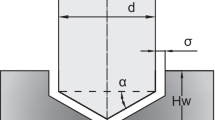Conclusions
-
1.
A systematic study was made of the milling of materials in the planetary centrifugal mill, and the optimum milling conditions, enabling powders with a specific surface of 40–50 m2/cm3 and a moderate iron impurity content (under 3 vol.%) to be produced in 30–40 min, were determined.
-
2.
It is shown that, in a general case, the process of comminution under PCM conditions is described by Rebinder's two-term equation, although in the milling of brittle refractory compounds only the second term of the equation is in fact operative. The comminutability of materials is determined by their physicomechanical properties; in milling in the PCM, it generally increases with increasing E, G, Hμ, and brittleness (i.e., with decreasing % and (ū2)1/2), just as it does in vibratory milling.
-
3.
Milling in the PCM is not suited to the comminution of ductile materials susceptible to cold welding, since these exhibit agglomeration.
-
4.
Pickup of impurities markedly grows with increasing abrasive power of powders, which is determined by both the nature of the material and the size and shape of its particles.
Similar content being viewed by others
Literature cited
A. A. Ivan'ko, Hardness — A Handbook [in Russian], Naukova Dumka, Kiev (1968).
V. M. Gropyanov, Activated Sintering of Materials of Increased Refractoriness [in Russian], Summary of Dissertation, LTI im. Lensoveta, Leningrad (1969).
I. N. Frantsevich, in: Problems in Powder Metallurgy and Strength of Materials [in Russian], No. 4, Izd-vo Akad. Nauk USSR, Kiev (1956), p. 14.
A. G. Dobrovol'skii, Yu. I. Nikitin, et al., Poroshkovaya Met., No. 6, 1 (1967).
B. D. Gurevich, L. B. Nezhevenko, et al., in: Refractory Carbides [in Russian], Naukova Dumka, Kiev (1970), p. 40.
G. V. Samsonov (editor), Physicochemical Properties of the Elements — A Handbook [in Russian], Naukova Dumka, Kiev (1965).
V. V. Stasovskaya, An Investigation of the Hardness, Brittleness, and Abrasive Power of Powders of Refractory Compounds [in Russian], Summary of Dissertation, IPM Akad. Nauk USSR, Kiev (1967).
V. E. Matsera, V. S. Pugin, et al., Poroshkovaya Met., No. 6 (1973).
P. A. Rebinder, P. A. Shreiner, and K. F. Figach, Softening Solutions for Boring [in Russian], Izd-vo Akad. Nauk SSSR, Moscow-Leningrad (1944).
G. S. Khodakov, Kolloid, Zh.,24, 236 (1962).
R. Chang and L. J. Graham, J. Appl. Phys.,37, 3778 (1961).
G. V. Samsonov and K. I. Portnoi, Alloys Based on Refractory Compounds [in Russian], Oborongiz, Moscow (1961).
W. Litz, High-Temperature Investigations [Russian translation], IL, Moscow (1962).
G. S. Khodakov, Dokl. Akad. Nauk SSSR,134, 574 (1960).
Fibrous Composite Materials [Russian translation], Mir, Moscow (1967).
Author information
Authors and Affiliations
Additional information
Translated from Poroshkovaya Metallurgiya, No. 7 (127), pp. 11–17, July, 1973.
Rights and permissions
About this article
Cite this article
Matsera, V.E., Pugin, V.S., Strashinskaya, L.V. et al. Comminution of powders in the planetary centrifugal mill II. Some milling characteristics. Powder Metall Met Ceram 12, 525–530 (1973). https://doi.org/10.1007/BF00796748
Received:
Issue Date:
DOI: https://doi.org/10.1007/BF00796748




